On the trail of Bernardino Luini in London
Since , I have been following the footsteps of Bernardino Luini on a recent flying visit to London I passed by the National Gallery and the Wallace Collection to have a look at his works on display there. Not that Bernardino ever went to London, of course, but due to avid 18th Century British Collectors buying his works from “broke” Italian aristocrats, a couple of his notable works have ended up in the National Gallery, in gallery B. Not that one should ignore the other works there, but I am on the trail of Bernardino , so there we are,
The National Gallery
The first of a notable pair of paintings is Christ and the Doctors. When exactly, Luini painted this one and indeed its provenance seem obscure but it appears to have finished up in the Aldobrandini apartments at the Borghese Palace in Rome. In the 1780s, it was apparently purchased by the English collector and art dealer Alexander Day, who spent much of his time in Rome and who then sold it to John Rushout, 2nd Baron Northwick, an English peer, landowner and collector of art works. Instead of going to Oxford or Cambridge Rushout was sent to Neuchâtel in Switzerland. In 1790 he visited Italy and while touring became friends with such luminaries as Edward Gibbon, Horatio Nelson, Sir William Hamilton and his wife Emma Hamilton, On his rather prolonged “Grand Tour” of Italy, Rushout developed a love of antique art from Sir William Hamilton and began to purchase collections of coins and other works of art.. He returned from Italy in 1800 when, on the death of his father, he succeeded to the titles of 6th Baronet Rushout, of Milnst and 2nd Baron Northwick.. Possibly Northwick thought he was buying a genuine Leonardo da Vinci at the time. However, by 1811, the Italian art historian Ignazio Fumagalli was attributing the painting to Luini .
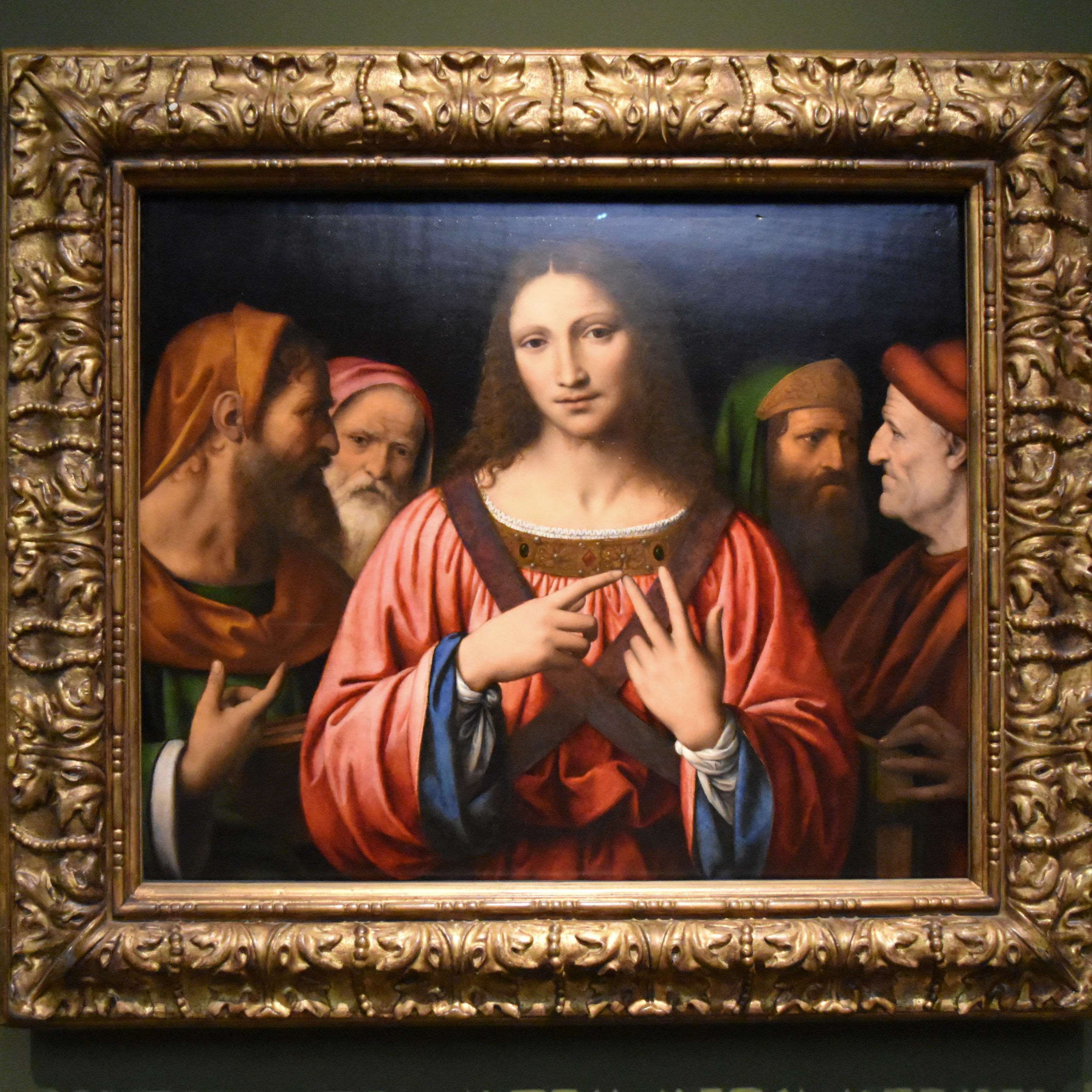
By the 1820s,, Lord Northwick’s had become somewhat financially over extended by his prolific art collecting and was forced to sell off parts of his collection. In 1824, the painting was sold to another British Collector the Rev W Holwell Carr . Carr was born in Exeter, , the son of Edward Holwell, an apothecary, and educated from 1776 at Exeter College, Oxford, where he graduated BA in 1783, MA in 1784 and BD in 1790, He remained as a Fellow until 1793, though apparently devoting most of his time to art. In 1781 he went to Italy where he studied art and began the picture-buying which was to become his lifelong passion. In 1791 the rich benefice of Menheniot in Cornwall, in the gift of the Dean of Exeter College and only available to Fellows, fell vacant and he hastily took holy orders. He never lived there, paying a curate £100 per year to fulfil his duties for him, but his income from the living helped fund his art collecting. He lived at Devonshire Place at the top of Wimpole Street in London. In 1797 he married Lady Charlotte Hay, daughter of James Hay, 15th Earl of Erroll , which presumably boosted his finances for more art collecting. Carr may have still believed the painting to be a genuine Leonardo. On his death in 1832, he bequeathed his entire collection of paintings to the nation. Shortly after his death the collection of thirty-five paintings was delivered to the National Gallery, where it has been ever since.
The work probably depicts a passage in the Gospel of Luke (2:41) in which the twelve-year-old Christ is discovered by his parents in the Temple of Jerusalem, debating the Holy Scriptures with the theologians, whom he astonishes with his wisdom. The event also referred to as “The Finding in the Temple” is frequently shown in art, and was a common component in cycles of the Life of the Virgin as well as the Life of Christ. In early Christian depictions, Jesus is often shown in the centre, seated on a raised dais surrounded by the elders, who are often on stepped benches. The gesture usually made by Jesus, pointing to his upraised thumb, may be a conventional rhetorical gesture expressing the act of expounding text. These depictions derive from classical compositions of professors of philosophy or rhetoric with their students, and are similar to medieval depictions of contemporary university lectures.
41 Now his parents went to Jerusalem every year at the Feast of the Passover.
42 And when he was twelve years old, they went up according to custom.
43 And when the feast was ended, as they were returning, the boy Jesus stayed behind in Jerusalem. His parents did not know it,
44 but supposing him to be in the group they went a day’s journey, but then they began to search for him among their relatives and acquaintances,
45 and when they did not find him, they returned to Jerusalem, searching for him.
46 After three days they found him in the temple, sitting among the teachers, listening to them and asking them questions.
47 And all who heard him were amazed at his understanding and his answers.
48 And when his parents saw him, they were astonished. And his mother said to him, “Son, why have you treated us so? Behold, your father and I have been searching for you in great distress”
49 And he said to them, “Why were you looking for me? Did you not know that I must be in my Father’s house?”
50 And they did not understand the saying that he spoke to them. 51 And he went down with them and came to Nazareth and was submissive to them. And his mother treasured up all these things in her heart.
52 And Jesus increased in wisdom and in stature and in favour with God and man.
Dürer painted a version of the in around 1506 ( now in the Museo Thyssen- Bornemisza, Madrid, ).during his stay in Venice, and led to the subject becoming popular there. Isabella d' Este requested Leonardo da Vinci to produce a work on the subject. Leonardo apparently never completed this work, but may have done preparatory drawings for it which inspired Luini .

In the painting a lively Christ is seen explaining things to the doctors with lively gesticulations, while with his left hand turned towards the back he raises two fingers, as if to organize his discourse into two fundamental points, and with the right he touches the first finger as if to begin his dissertation. Jesus looks at the viewer serenely as he counts the points of his argument off on his fingers. The picture is sometimes thought to be the adult Christ disputing with the Pharisees, as he looks rather older than twelve years of age.
:Luini returned to the same theme of Christ Disputing with the doctors (Disputatio) on a somewhat larger scale in his fresco at Il Santuario della Vergine, in Saronno. If the work in the National Gallery is the close -up version, then the Saronno version is expanded to widescreen, with more characters and a lot more going on. The model for the young Jesus looks pretty similar to Jesus in the Cristo Benedicente ( Christ Blessing) in the collection of the Pinacoteca Ambrosiana in Milan.
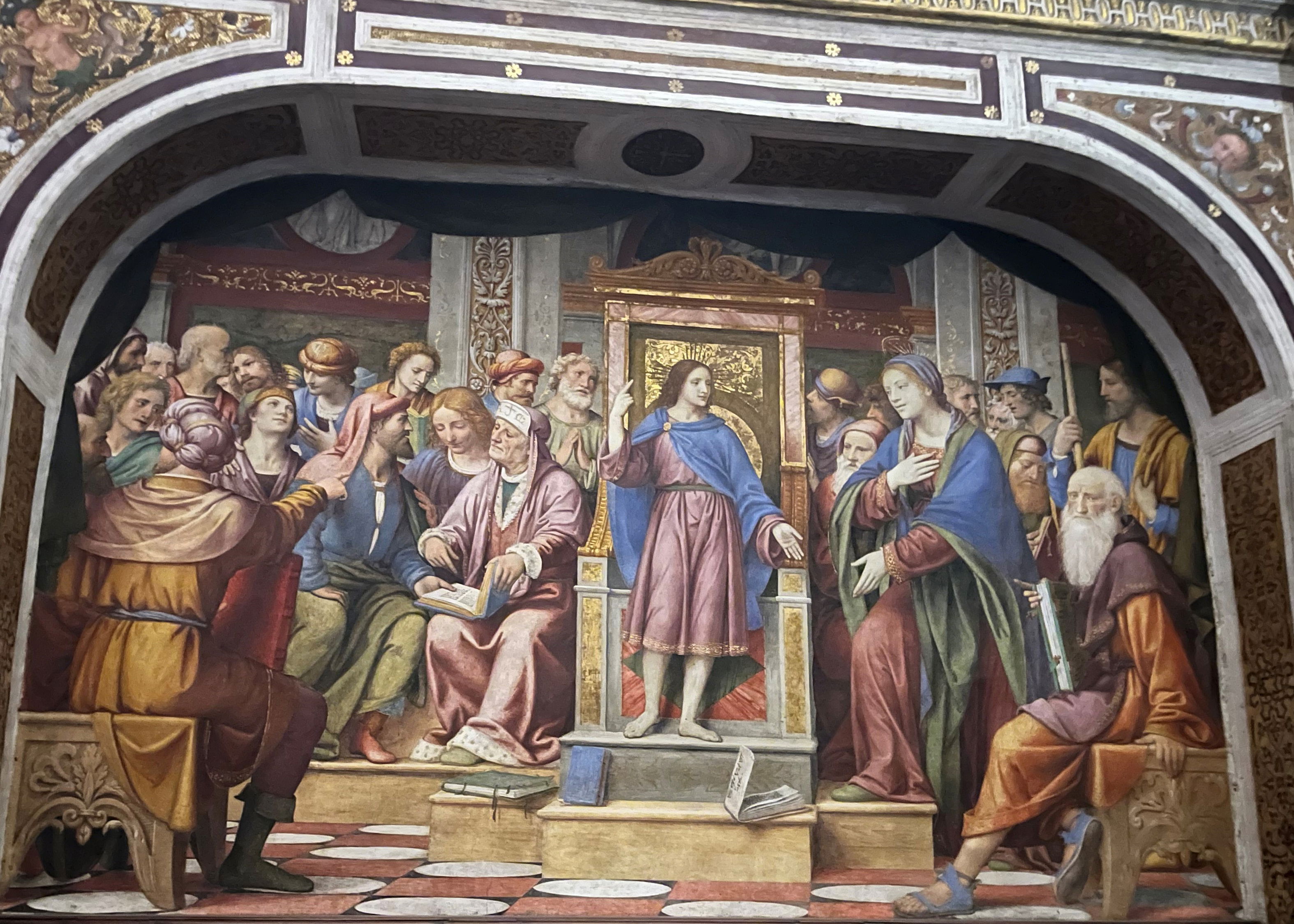
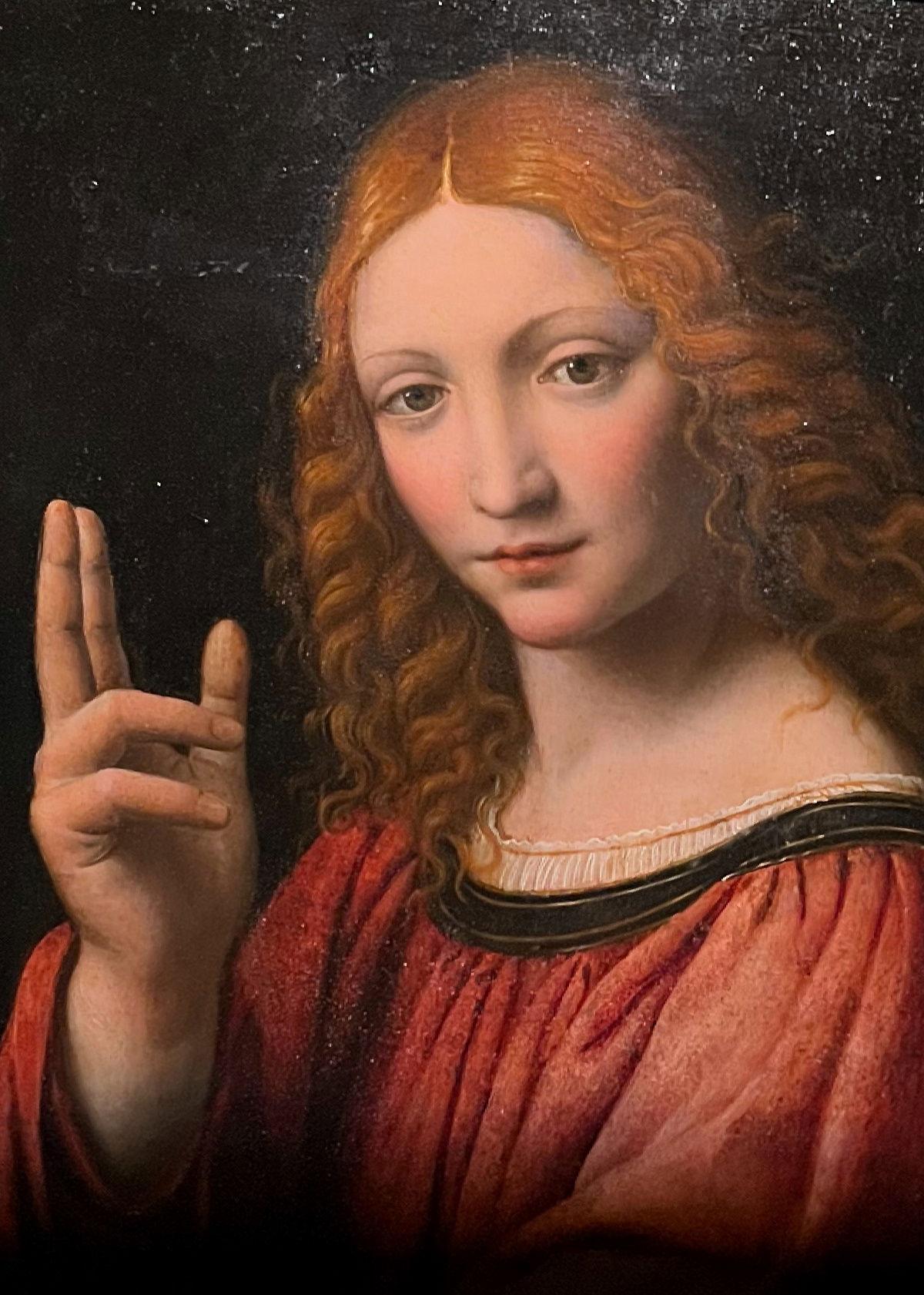
The second Luini work is the Virgin Mary with Jesus and St John The Baptist. The painting was originally in the collection of Ludwig Mond in London and was bequeathed to the National Gallery in 1924 as part of the Mond Bequest. The precise history before that seems obscure, but presumably it was also purchased by British collectors in Italy.
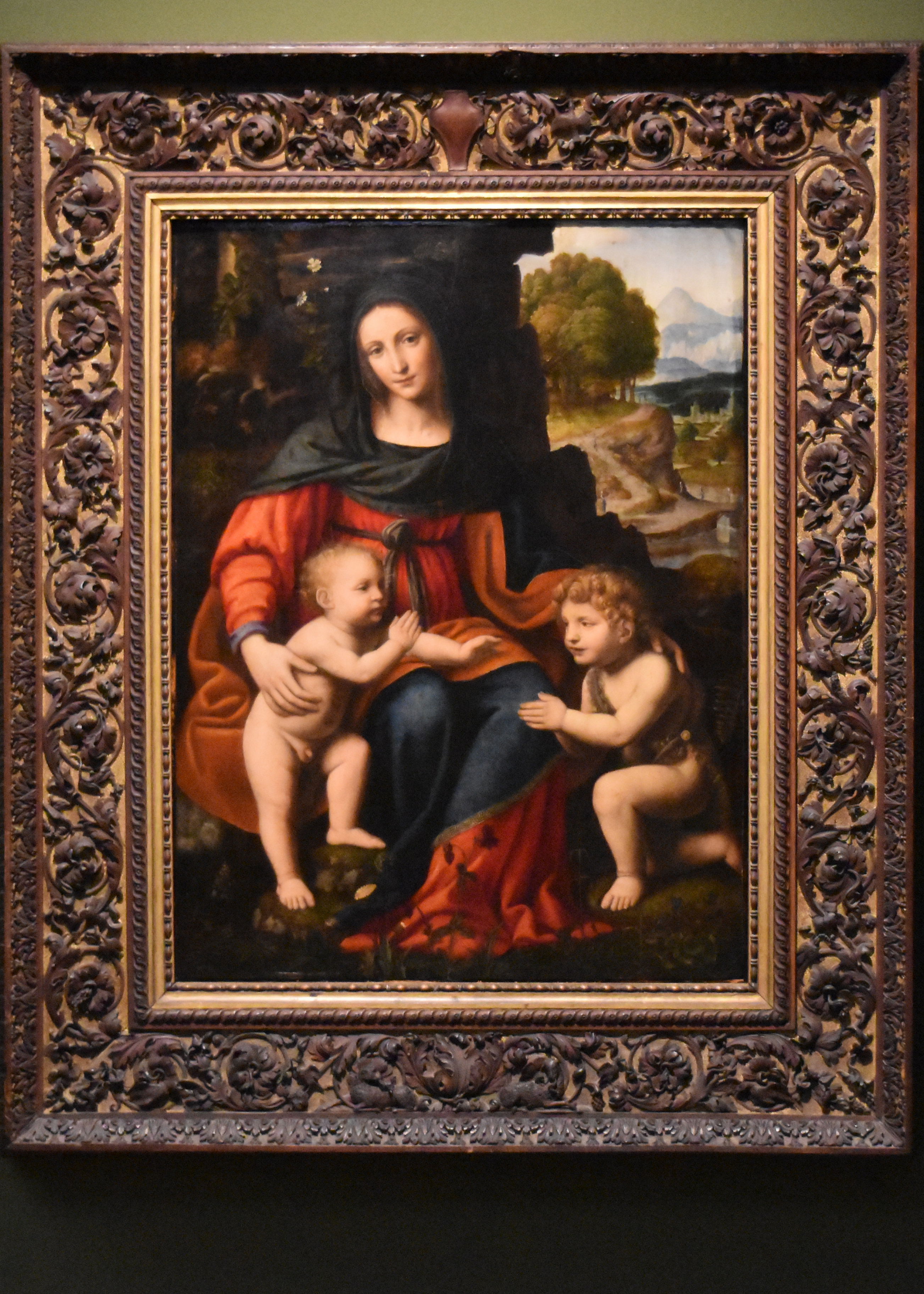
In this painting, the Virgin Mary sits in the shelter of a rocky grotto or cave. The infant John the Baptist, wearing his traditional camel skin, clasps his hands in prayer and kneels before Christ, who raises his right hand, perhaps to make the sign of the cross over him. The Virgin looks at the viewer as she gently draws the children to her. The landscape, with its distant mountains , a river meandering across the plain and a small fortified town look typical of Northern Italy, possibly around Luini’s home area of Lake Maggiore or Lake Lugano.
The plants which are growing in the foreground, are painted in some detail appear to be lupin, dandelion, columbine, wheat and violet all of which are native to northern Italy and all have a symbolic Christian significance. The flower beside the Virgin’s face may be white campion, which may symbolise her purity. White campion, or Silene latifolia, is a species of flowering plant in the carnation family. It is native to most of Europe, Western Asia and Northern Africa, typically found in Spain, France, Italy and is able to thrive in a wide range of conditions, tolerating both sunny and shady conditions and a variety of soil types. The white campion is known for its beautiful white flowers, which typically bloom from late spring to early summer. The flowers are fragrant and attract a wide range of pollinators, including bees, butterflies, and moths. The flowers give way to small, round seed capsules that contain numerous seeds. These seeds are dispersed by the wind and can quickly colonize new areas. Which might be seen as propagating the Christian faith.
The Columbine flower takes its name from the Latin for dove, due to the resemblance of the inverted flower to five doves clustered together. The Dove was of course a sign of peace and the columbine plant was assigned to Christ, furthermore a symbol of humility, the Holy Spirit and the Holy Trinity. The flower was also seen as a symbol of courage and strength. The Greek name for carnation, dianthos, means “flower of God,” and for this reason the carnation often appears in paintings of the Madonna and Child. Dianthus caryophyllus is a species of Dianthus native to the Mediterranean region. Legend has it that carnations first bloomed from the ground where the Virgin Mary shed tears over Jesus’ suffering and death on the cross. As a result, carnations have come to symbolize the love and sacrifice of the mother of Jesus, as well as the love and sacrifice of Jesus himself. The colours of carnations also have specific meanings in Christianity. For example, white carnations are associated with purity and represent the purity of the Virgin Mary, while red carnations are associated with the blood of Jesus and represent his sacrifice. Violets were often associated with the Virgin Mary and considered a symbol of her humility and purity. The colour purple, derived from violets, was also associated with royalty and is used during the liturgical season of Lent. In ancient times, the violet flower was highly valued for its diverse uses and held a special place in many societies. The Greeks, for example, believed that violets were a symbol of fertility and love. The Romans believed that the flower had healing properties and used it in various medicinal remedies. Violets were also associated with death and were often used in funeral rites and placed on graves as a symbol of remembrance. In the Christian tradition, the violet flower symbolizes humility, modesty, and spiritual wisdom. Violets were also associated with the Lenten season, representing the virtues of purity and repentance. One might therefore hazard a guess that the season is Spring.
Symbolic flowers were also prominently included in Leonardo’s painting the Virgin of the Rocks, although it is less easy to identify the types. The composition with the grotto and the rocky background are also similar, albeit in a sort of mirror image. Leonardo da Vinci was working in Milan from about 1482 to 1499 It is possible that The Virgin of the Rocks was being completed in Leonardo’s studio in Milan between 1506 and 1508, when Luini may have seen it or even assisted with parts of it.
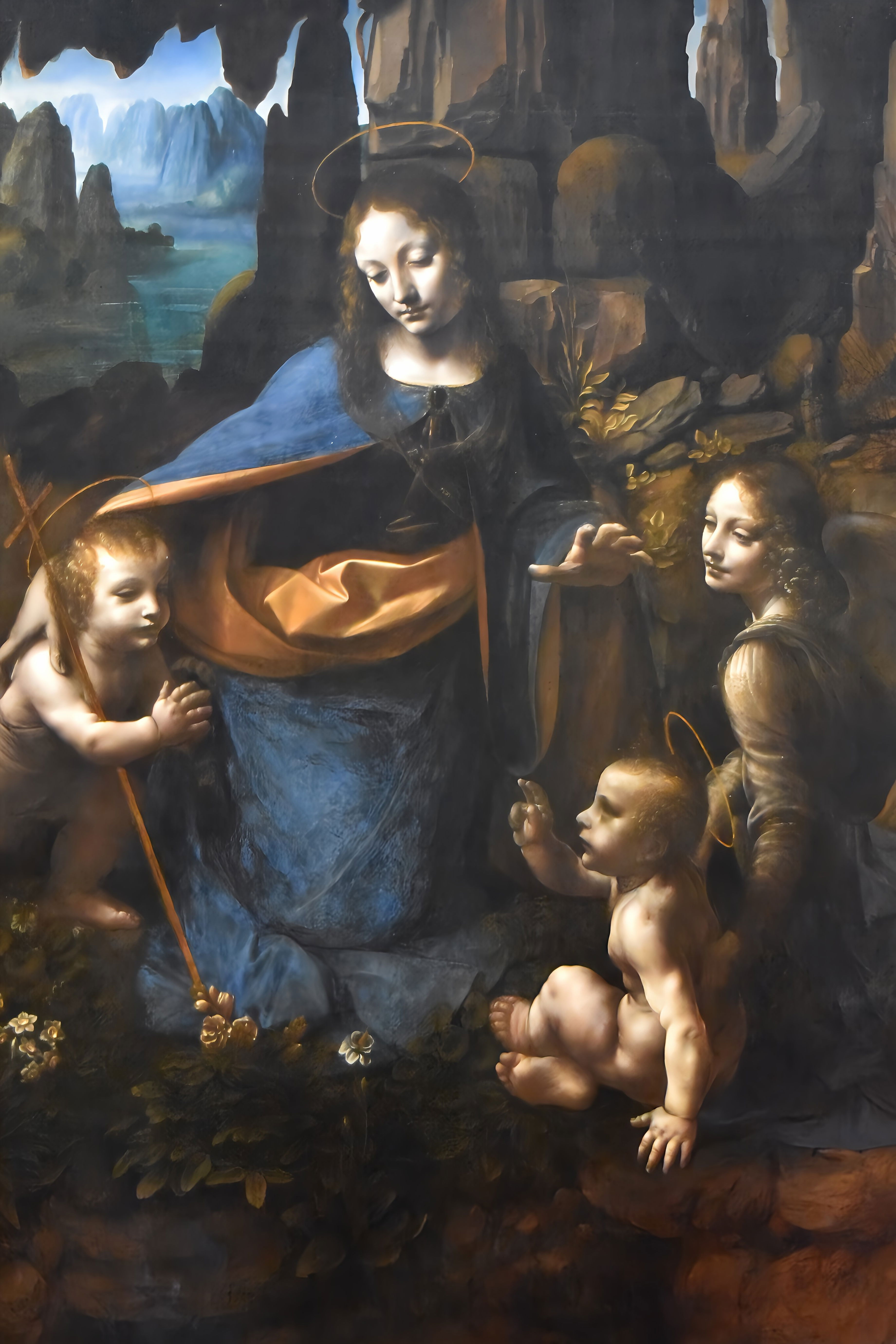
There is another version of this composition by Luini in the Fogg Art Museum, Cambridge, Massachusetts. In that picture the Virgin looks down towards Christ and the distant landscape includes a gatehouse over a river. The flowers are mostly positioned beside the Virgin’s head, suggesting that they symbolise her qualities. The flowers in the foreground are absent. The Fogg Museum painting apparently dates to the 1520s, presumably after the National Gallery.

Technical examination of the National Gallery’s picture reveals several changes were made during painting. The position of Saint John’s head has been moved; it was once inclined towards the Virgin in a position closer to the Fogg Art Museum’s version. There are other small changes to the figure of the Baptist, the most noticeable being in the position of the hands.
The Wallace Collection
Also in London , the Wallace collection in Hertford Square possesses an interesting selection of works by Luini. Two Madonnas and two pieces of fresco from the Villa Pelucca, near Monza.

The Wallace Collection, London
The first Madonna is a painting in oil on poplar, thought to be an early work by Luini. The representation of the Virgin as mother holding the Christ Child entered the West through Byzantine art. Luini has imbued the relationship of mother and child became increasingly with the greater human feeling typical of the Renaissance. The religious sense of the image was conveyed by means of symbolic attributes laid out in front of the Madonna. The book may refer to Christ’s innate wisdom, and may also be a forerunner of the Gospels. There is an ivory teething stick, with black ribbons, which recalls the innocence of Jesus as a child and the suffering of teething. The white sheet, a symbolic winding sheet, foretells the shroud and the death of Jesus. The Virgin wears her traditional colours of a red robe beneath a blue cloak, and is posed in an attitude of humility with downcast eyes. In medieval theology, humility was regarded as the basis for all other virtues, and thus as an appropriate attribute of the Mother of Christ. The provenance of the painting is unknown, until it was acquired by Richard Seymour-Conway, 4th Marquess of Hertford, sometime before 1854.
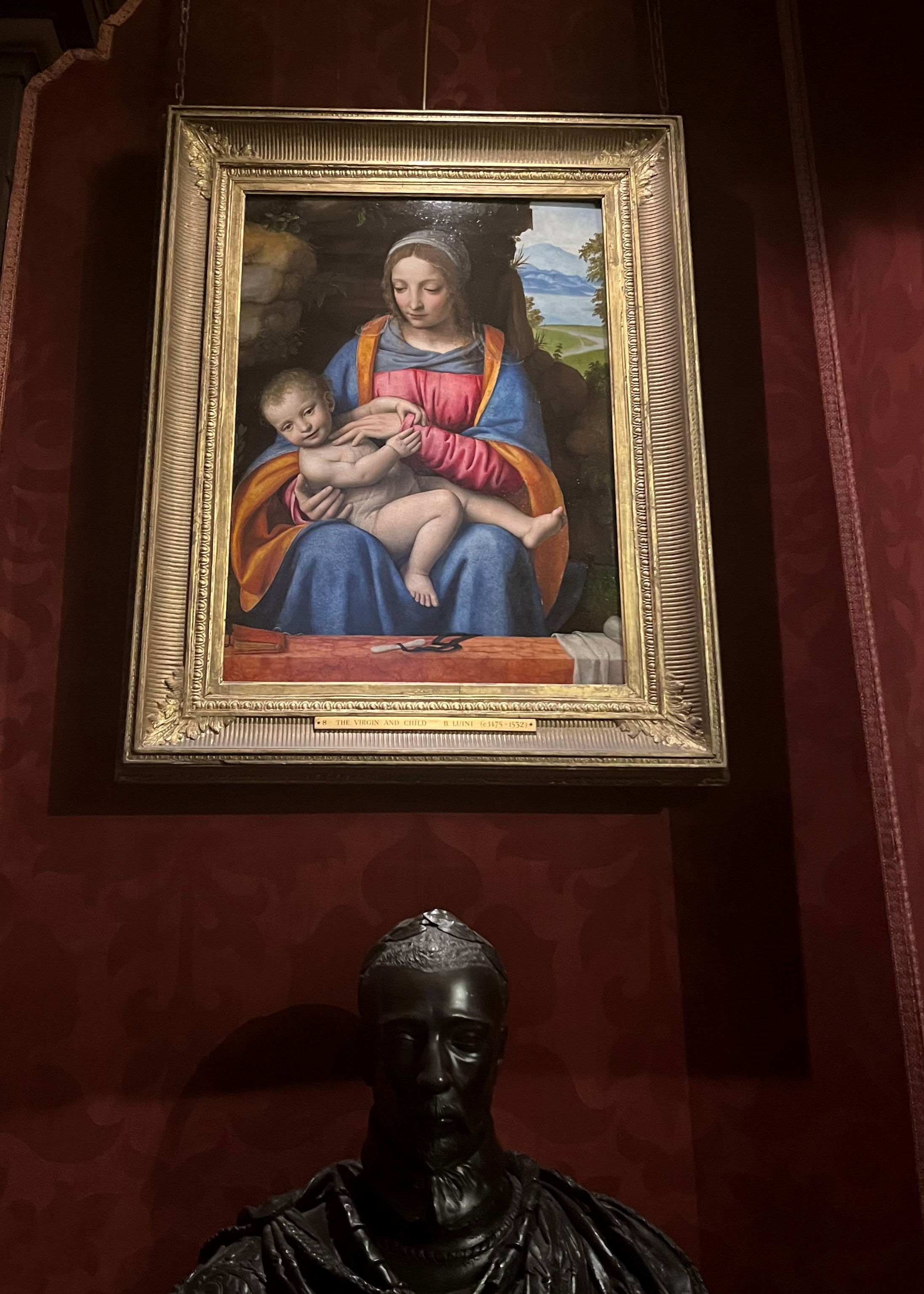
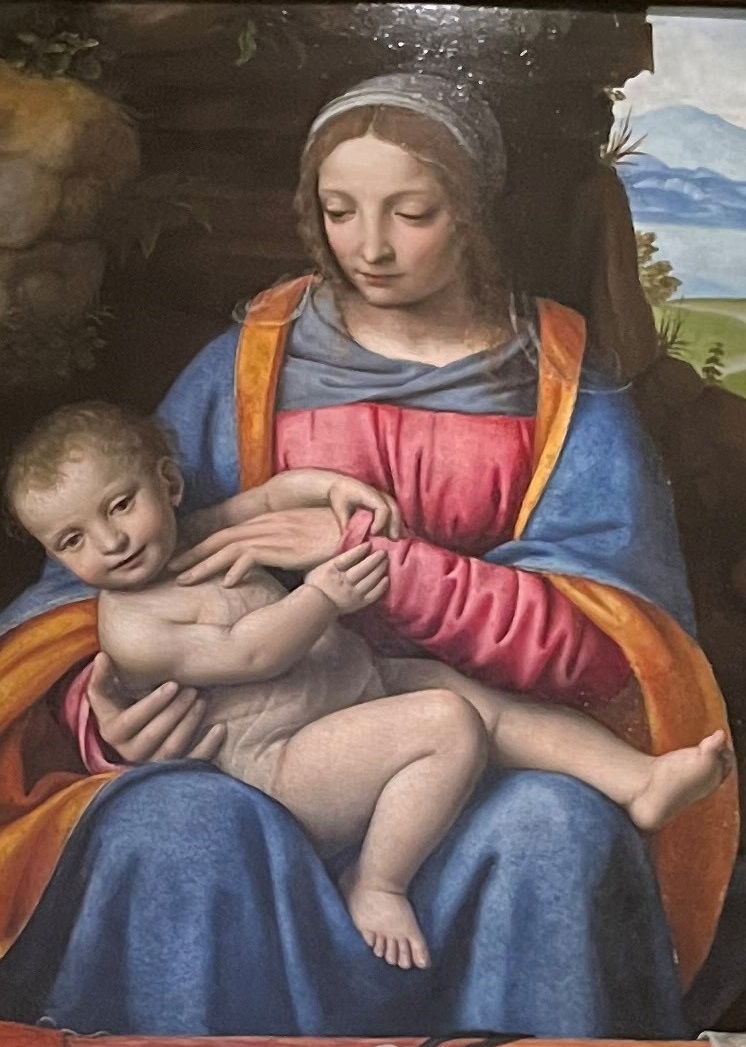
Madonna and Child from the Wallace Collection in London
The second Madonna and child, Madonna with Colombine, was originally attributed to Leonardo. The wisdom and innocence of Jesus are here conveyed through his physical youth combined with his confident pose, twisting to read the holy book open at his feet. His mother reads over his shoulder, confirming her role as the Mother of Wisdom, and foretelling the Passion of Christ by her sorrowful expression. Both clasp the stem of a columbine, as discussed above the shape of the Colombine flower was thought to resemble doves in flight, and was thus seen as a symbol of the Holy Ghost. The composition is typical of Luini’s contemplative, elegant style, and similar compositions exist . It was attributed to Leonardo da Vinci when bought by the 4th Marquess of Hertford for the substantial sum of 83,500 francs (about £3,340).
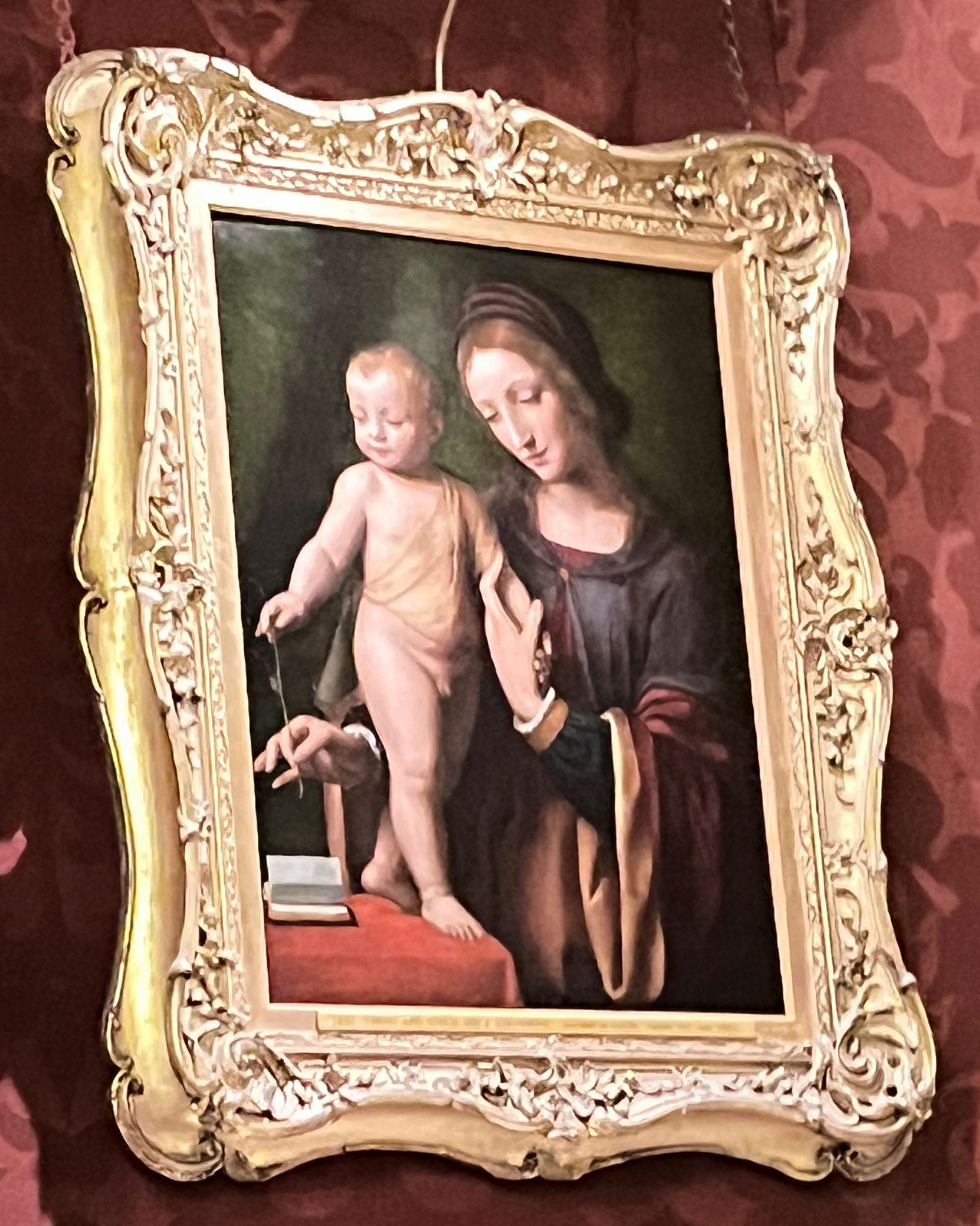
Madonna and child with Colombine
The Head of a Girl comes from Luini’s frescoes at the Villa Pelucca, Gerolamo Rabia’s country house at Sesto San Giovanni, near Monza. Luini decorated three rooms and the chapel . Other frescoes including the Bathing Nymphs are at the Brera, Milan, while other fragments can be found at Chantilly, Musée Condé; and Isola Bella, in the Borromeo collection.
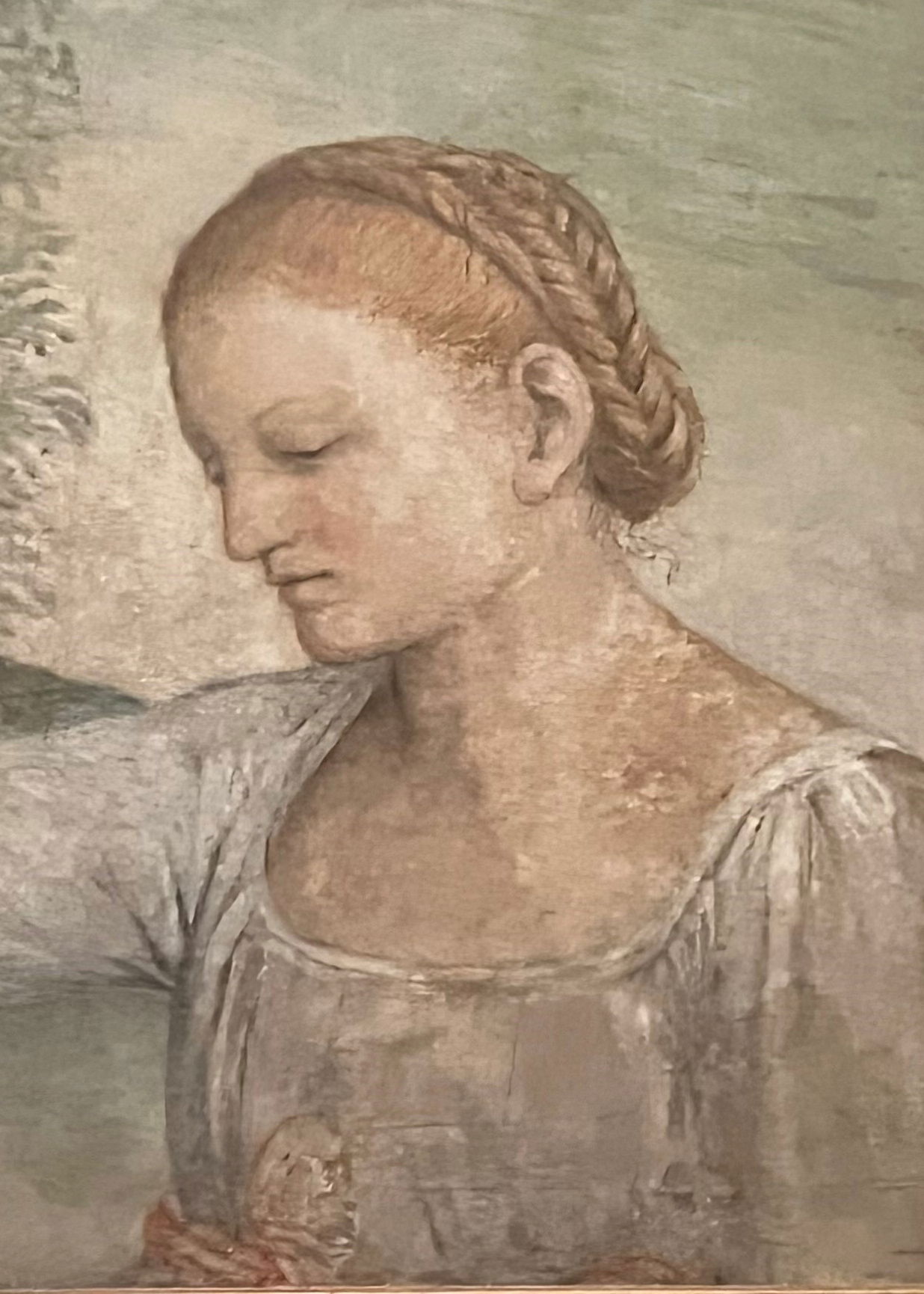
The Head of a Girl, fresco from the Villa Pelucca at the Wallace Collection
From the same location comes a Putto picking grapes also comes from the Villa Pelucca. After the French occupation of Lombardy, the villa belonged to Eugène de Beauharnais, the French viceroy in 1806, when the frescoes were badly restored. When, in 1816, the Austrian government proposed to turn it into a farmhouse, the Brera Accademia obtained permission to detach some of the frescoes. Twenty-five fragments were removed between 1821 and 1822, and exhibited at the Brera and the Palazzo Reale. Their appearance fuelled the interest of collectors and a number of additional fragments were removed, including the present two pieces, and found their way into private hands. Sir Richard Wallace purchased both pieces from the Duca Antonio Litta-Arese-Visconti in Milan in 1872.
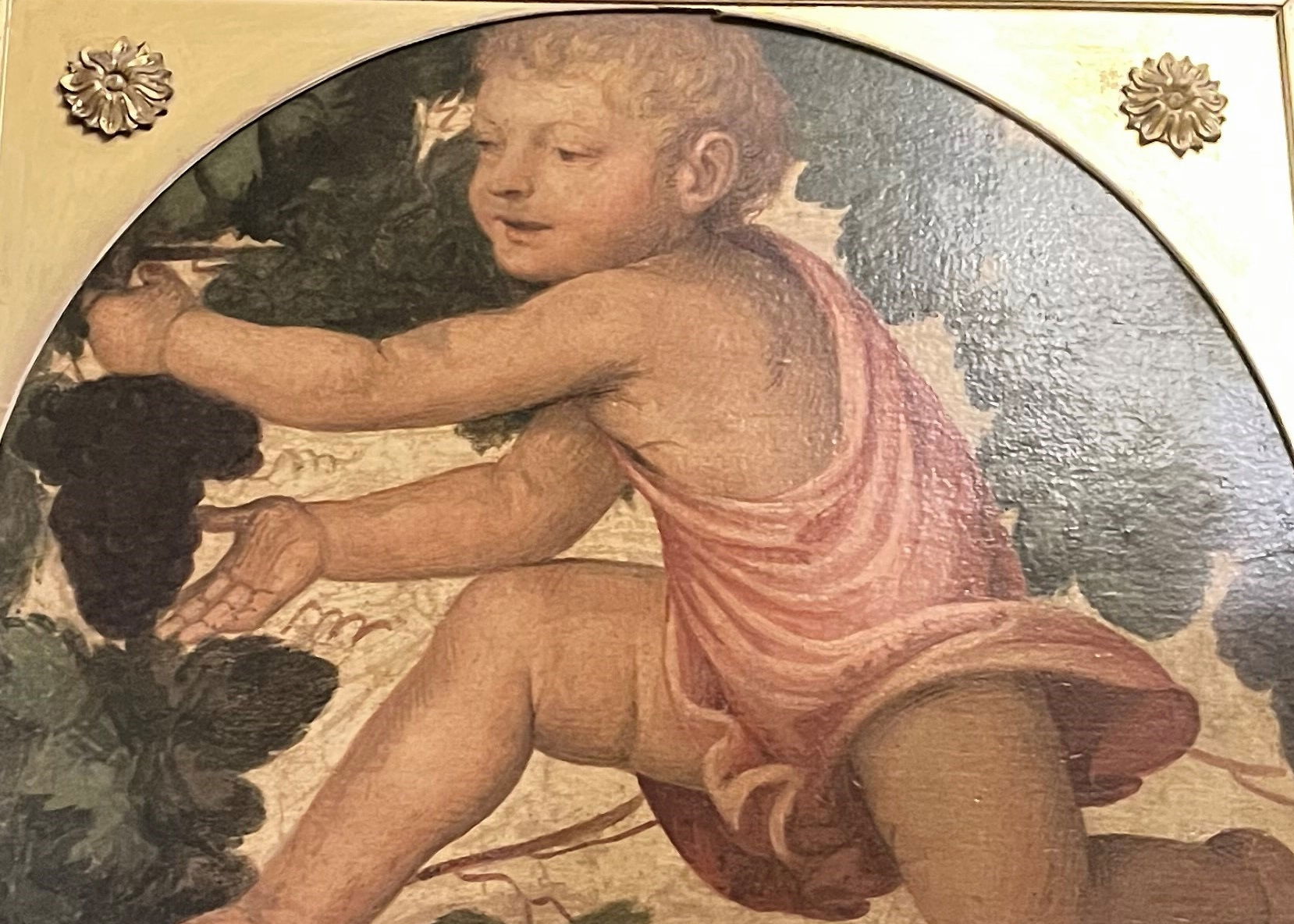
Putto picking grapes from the Villa Pelucca

More Putti and bathing nymphs from the Villa Pelucca, from the Brera Gallery in Milan